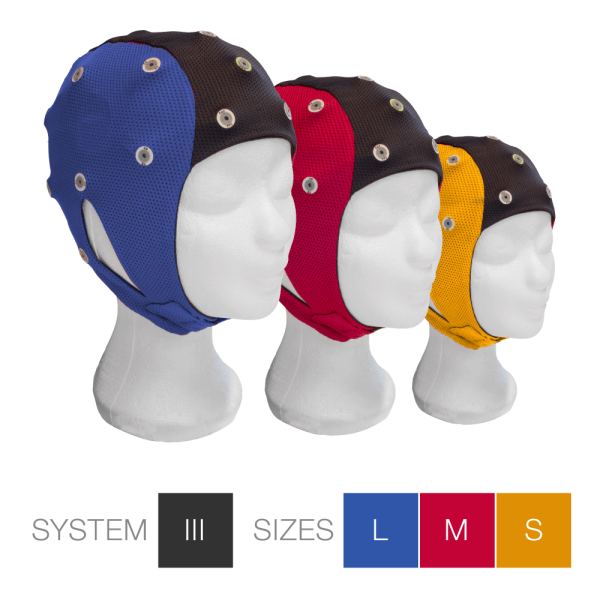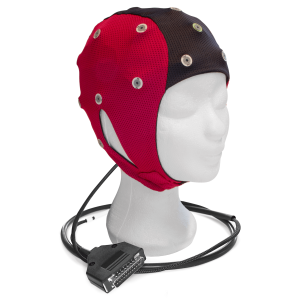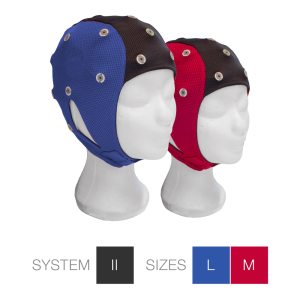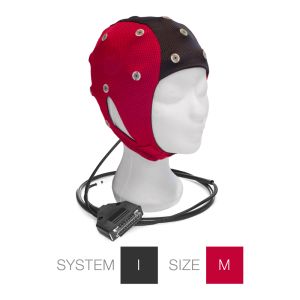We use cookies to make your experience better. To comply with the new e-Privacy directive, we need to ask for your consent to set the cookies. Learn more.
WaveGuard Connect 19 Channel Cap System III
- All the supplies you need for preparing a qEEG
- Includes 3 caps. Small, Medium & Large
- Exceptional cap comfort and quality
- Compatible with major EEG amplifiers
In Stock
WaveGuard Connect's exceptional comfort and quality combined with all of the basic accessories you need for preparing a QEEG. Includes all the necessary supplies and three cap sizes covering most head sizes.
- Small WaveGuard Connect Cap
- Medium WaveGuard Connect Cap
- Large WaveGuard Connect Cap
- Electrode Board Adapter
- (10) Needle/Syringe Kits
- (3) Electro-gel 16oz.
- (3) Replacement Silicon Rings
- Detergent for cleaning caps
- Head tape measure for sizing
WaveGuard Connect’s exceptional comfort is achieved through the use of soft silicone electrode cups instead of the hard, uncomfortable plastic cups that are commonly used in competing caps
The EEG caps feature hidden wiring and high density connectors, making the use and maintenance of the caps quick, safe, and easy. waveguard connect is perfect for routine diagnostics where good signal quality is crucial for valid assessment.
Maximum comfort for patients
The breathable Coolmax™ fabric in combination with soft silicone electrode cups ensure comfortable fit over extensive periods of time. While being soft to the skin, the durable fabric includes an effective fiber-based moisture management system which takes care of derivation of perspiration away from the body in warm environments. The soft electrode rings lessen the pressure from the electrode sensors, which is essential in reducing skin irritations that are caused by many other available EEG caps in the market.

Optimal signal quality
Tin has been widely used for many years in clinical and research areas with good longevity and signal quality. It is the most commonly used electrode sensor material in clinical applications as it has proved to be very reliable in AC coupled clinical recordings with frequency range higher than 0.5 Hz. waveguard connect electrode sensors are made of pure, solid tin which provide the user with optimal signal quality at all times.
Quick and easy application
All cap electrodes are pre-positioned according to the international 10/20 system. Thanks to the pre-positioned electrodes, the application of the caps is easy and the preparation time for each patient is significantly reduced as compared to placing each electrode individually. The entire procedure from preparation and gelling to recording is achieved in less than 10 minutes!
Straightforward connection
The waveguard connect caps are compatible with all major EEG amplifiers used in clinical environments, such as NicoletOne and Mitsar. The EEG caps come by default with a D-SUB 25 connector for a quick and straightforward connection. A D-SUB to single point touch-proof adapter can be additionally purchased for interaction with other third-party amplifier head-boxes.

Only 6 sizes to fit baby- adult size heads
The waveguard connect caps are available in 3 different configurations, 6 sizes, ranging from 21 up to 64 EEG electrodes, all featuring the international 10/20 system layout.

Different colors for different sizes
We have applied four distinct colored fabrics in specific combinations to allow a quick selection of the right size. A size label can be found at neck.

Easy cleaning and short drying times
Cleaning is a very important step of preserving the cap's condition. Cleaning of the waveguard connect cap is simple and easy. Watch the video below!
- Most suitable EEG cap for AC coupled clinical recordings
- Proven design and high quality at best price on the market
- Great wearing comfort for patients, also in lying position
- Few sizes fit all, full coverage of adult head circumferences
- Easy to use, simple to maintain
- Straightforward connection to all major clinical EEG systems (e.g. NicoletOne®, Nihon Kohden®, Mitsar®, Micromed® etc.)
- No loose wires - safe use and maintenance
- Tin (Sn) electrodes provide excellent signal quality for routine use, especially in AC coupled clinical recordings
- Desinfectable caps, short drying times
- 4 months of warranty
- Saving costs and waste due to less frequent equipment supply
WaveGuard Connect frequently asked questions
Q: How many times can a WaveGuard Connect cap be used?
A: The number of times that a cap can be used with all electrodes intact and without compromising signal quality depends upon many factors. Careful handling and thorough cleaning are most important. The electrode sensors, the fabric along with all other parts and materials have been selected and designed to reach more than 500 cycles of recording and cleaning.
Q: What is the main difference between Tin(Sn) and Ag/AgCl electrodes?
A: When selecting sensor material for EEG electrodes, most important aspect is its ability to withstand corrosion and preserve its conductance. Tin and Ag/AgCl-Electrodes have been widely used in the clinical and research areas with overall good longevity and signal quality. However, tin electrodes tend to attenuate low frequencies more than Ag/AgCl electrodes . Other sources have found no difference between these two electrodes especially for measuring ERPs and SCPs. It is widely agreed, that the filtering caused by the electrode is no more severe than the typical filter setting of an EEG amplifier. Either tin or Ag/AgCl electrodes are adequate for clinical use, but Ag/AgCl may be preferred when very slow potentials are being recorded.
Q: What is the advantage of a cap with pre-positioned electrodes over loose electrodes?
A: The pre-positioned electrodes are positioned following the international standard 10/20-System. This is the most usual montage setting and covers the frequently used electrode positions. Due to the pre-positioned electrodes in WaveGuard Connect, the time for preparing each patient is significantly reduced. The WaveGuard Connect electrodes are covered by two fabric layers to guarantee best protection for the electrode body and cables. It increases the longevity of the whole electrode system and saves cost and reduce waste due to less frequent purchasing of equipment supply.
Q: Can the electrodes be removed from the cap?
A: The pre-positioned electrodes of WaveGuard are covered by two fabric layers to guarantee best protection for the electrode body and cables. The electrodes can be manually removed, but then the warranty would forfeit. In case an electrode is not required, please deactivate these electrode channels in the recording and/or analysis software.
Q: Is the cap clinically tested?
A: WaveGuard EEG caps are compliant to the international standards for medical devices. The WaveGuard EEG cap is a medical device CE marked according to EU regulation. In the USA, WaveGuard EEG caps have FDA 510(k) clearance and in Canada WaveGuard caps are registered as medical device according to the C-MDR.
Application
Q: How to apply the cap?
A: The application of the WaveGuard cap follows five essential steps:
- Preparing the patient
- Positioning the cap
- Fixating of the cap
- Connecting the cap to EEG recording system
- Applying gel and checking impedances
Watch the video guide on how to apply the WaveGuard Connect EEG caps
Q: How long does it take to apply a WaveGuard Connect cap?
A: The application time depends greatly on the number of EEG channels that need to be recorded. Normally, gelling each electrode will take approximately 20 seconds. The whole process of patient preparation, putting on the 23-channel cap and gelling it, should take maximum 10 minutes.
Q: What do I need for an EEG recording
Preparation for an EEG recording video
Connect to EEG
Q: How to connect a WaveGuard Connect cap to a third-party system?
A: The WaveGuard caps are compatible with all major EEG amplifiers used in clinical environment such as Nicolet or Mitsar. The WaveGuard Connect EEG caps come with a default D-SUB 25 connector. D-SUB to single point touch-proof adapter can be additionally purchased enabling interfacing to third-party amplifier head-boxes.
When using the Brainmaster Discovery with the WaveGuard caps - they do not require ear electrodes as the ear electrodes as they are already included in the cap (M1 and M2, behind the hears). Plug M1 in A1 and M2 in A2 and leave the reference unplugged. Do not gel the reference.
Recording
Q: How can I check if the electrodes are working properly?
A: Before starting the recording, please check whether all electrodes are functioning properly. A well-functioning electrode will correctly record the EEG signal with low impedance and high Signal-to-Noise-Ratio (SNR). Both parameters can be easily checked in EEG recording software.
Q: How long can I record data without re-gelling the subject?
A: Once the gel is applied, there is no need to re-gel the subject for at least 6 hours.
Q: Is it possible to re-gel the electrodes during the experiment?
A: Yes, it is always possible to re-gel, however, it is necessary to pause the recording in order to avoid any needle related artefacts or electrode movement artefacts.
Q: How long can I record with a WaveGuard Connect cap?
A: As the cap is made of breathable fabric and flexible electrode rings, it assures optimal comfort even in long recordings. The maximal recommended duration of a single recording is 6 hours.
Cleaning and Maintenance
Q: How to disinfect the cap?
A: Make sure that the cap is adequately cleaned prior to the disinfection procedure.
Examples of disinfectant solutions that are known to work satisfactory are:
- Metricide, Cavicide (by Metrex)
- Cidex OPA (by Advanced Sterilization Products)
- Korsolex Extra (by BODE Chemie).
Above liquids are considered high-level disinfectants, whereas for your normal clinical use a ‘lower-level’ product may suffice. Please consult with your local infection-control officer about possible alternative products or allowances in e.g. reduced concentration levels and/or shorter submerging times for the caps. Other than this, the disinfectant's instructions for use and rinsing must be followed strictly at all times. Plastic parts, such as labels, flex-rings and the fabric, may bleach slightly over time. This is normal and does not interfere with the normal usage of the cap. The use of disinfectant may slightly reduce the normal lifespan of the caps.
Please note that alcohol is not an adequate solution for disinfecting electrodes. The local and hospital regulations for cleaning should not be neglected in the process and must be followed. For questions, please do not hesitate to contact us.
Q: Can the cap connectors get wet?
A: The connectors must not get in contact with water under any circumstances. Avoid any moisture near the connectors in order to completely prevent possible short-circuits or corrosion. In the event that you need to clean the connectors, use a cotton stick slightly damp with alcohol (do NOT use this on the electrodes).
Q: How long does a WaveGuard cap need to dry?
A: We recommend to dry the WaveGuard cap in a non-humid room with a table fan with a fence, over which you can suspend the cap. With a constant air stream, the drying time can be reduced to 20 minutes.
Do not try to wring or squeeze the cap. We recommend to gently dab the cap fabric using a towel, or to hold the cap between two towels before further drying, e.g., using the table fan.
Q: Is it possible to record data with a wet cap?
A: No. The caps must be used only when clean and dry.
Warranty
Q: What is the warranty time of a WaveGuard Connect cap?
A: ANT Neuro offers a standard warranty for WaveGuard Connect for 4 months, in order to cover possible material defects or errors in production.
- Small WaveGuard Connect Cap
- Medium WaveGuard Connect Cap
- Large WaveGuard Connect Cap
- Electrode Board Adapter
- (10) Needle/Syringe Kits
- (3) Electro-gel 16oz.
- (3) Replacement Silicone Rings
- Detergent for cleaning caps
- Head tape measure for sizing





